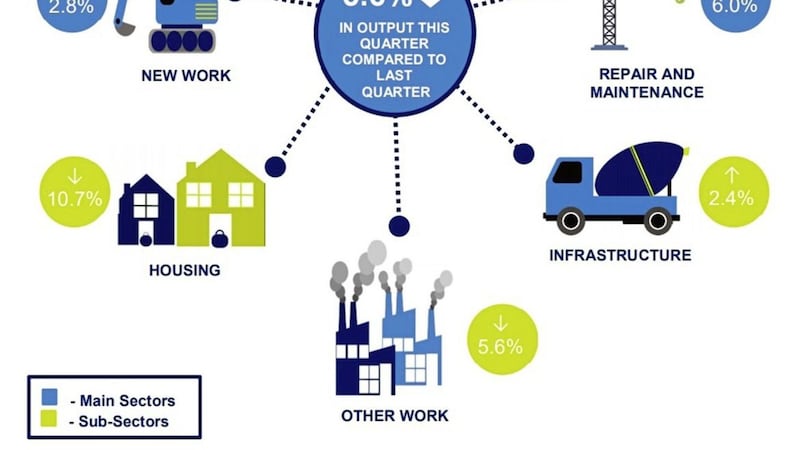ECONOMIC output in the north increased by 0.3 per cent between April and June, but output in the construction sector fell considerably from the start of the year.
New official government data from the Northern Ireland Research and Statistics Agency (NISRA) showed that the total volume of construction output in the second quarter of 2019 fell 5.6 per cent from January to March. The biggest factor appeared to be a six per cent decrease in repair and maintenance work.
Despite a 2.4 per cent increase in infrastructure in the second quarter, housing fell 10.7 per cent over the quarter.
As a whole, output across the north’s economy increased one per cent from the second quarter of 2018 to Q2 2019, according to the Northern Ireland Composite Economic Index (NICEI).
Considered the closest measure to GDP in Northern Ireland, the increase over the second quarter of 2019 was largely driven by the services and production sectors.
NISRA said that economic activity in the north grew faster than UK GDP over the quarter, but remained slower when analysed over the year.
UK GDP fell 0.2 per cent over the second quarter, but was up 1.3 per cent for the year to Q2 2019.
According to NISRA’s analysis: “When the trend in the index is considered over the last three years, there is evidence that the rate of growth has picked up.
“Over the last two years, growth in Northern Ireland output increased by 1.5 per cent, compared to UK growth of 1.7 per cent. This was an increase on the NI growth rate compared to the two years to Q2 2018 (-0.1 per cent). NI's private sector output increased by 0.2 per cent over the quarter, and over the year by one per cent.”
The index remains 4.2 per cent below the high point recorded in the north during the second quarter of 2007. UK GDP in the second quarter was estimated to have been 12.9 per cent higher than its pre-economic downturn peak at the start of 2008.
“The latest NICEI results continue to show that the UK has had a shorter downturn and a faster recovery than NI,” states the NISRA analysis.
Grant Thornton chief economist Andrew Webb described the data as “encouraging”, especially in the context of the UK where second quarter figures revealed a decline in economic performance.
“Looking at the sectoral contributions to growth does however reveal some mixed fortunes across the economy,” he said.
“Production lead the way, contributing 0.6 percentage points to the one per cent quarterly growth. The service sector had a reasonably flat quarter two, contributing 0.3 percentage points to quarterly growth. The hope would be to see this lift in quarter three with a boost from a bumper tourism season.”
The economist said the fall in construction output was largely driven by a decline in house building.
“This will add to concerns about housing shortages, particularly in social housing,” he said.
“On a positive note, infrastructure output was up over the quarter and is at the highest level since 2012.
“Given recent infrastructure deficit announcements from bodies such as NI Water, and planned improvements to the road network, there is no shortage of demand for new infrastructure.
“That will obviously require significant budget decisions to be made, the absence of which are reported to be constraining the construction sector somewhat.”








